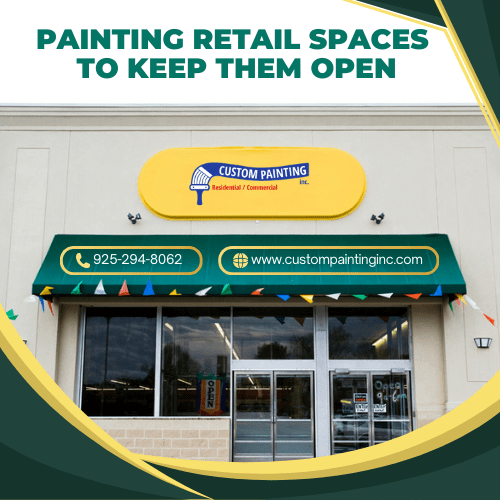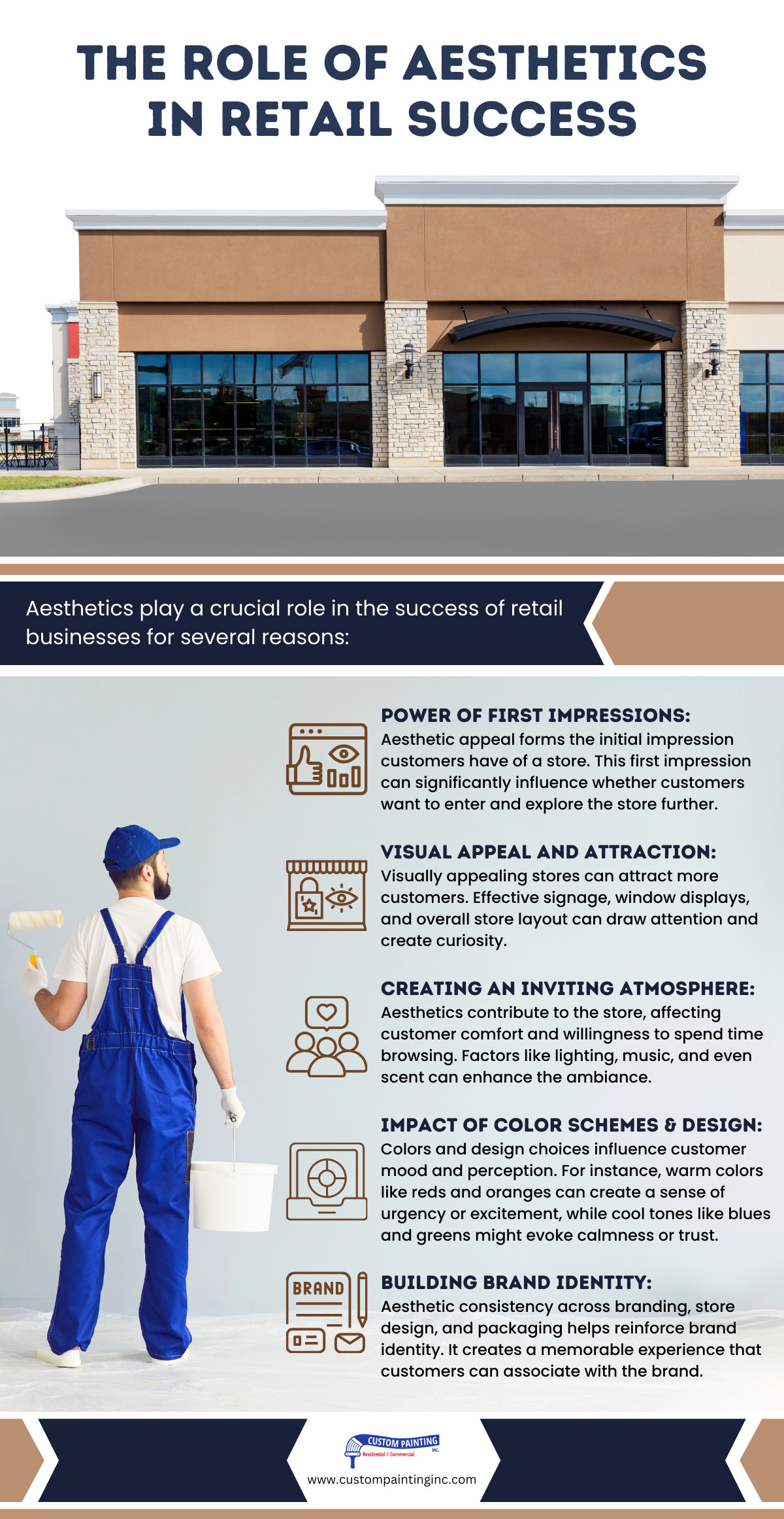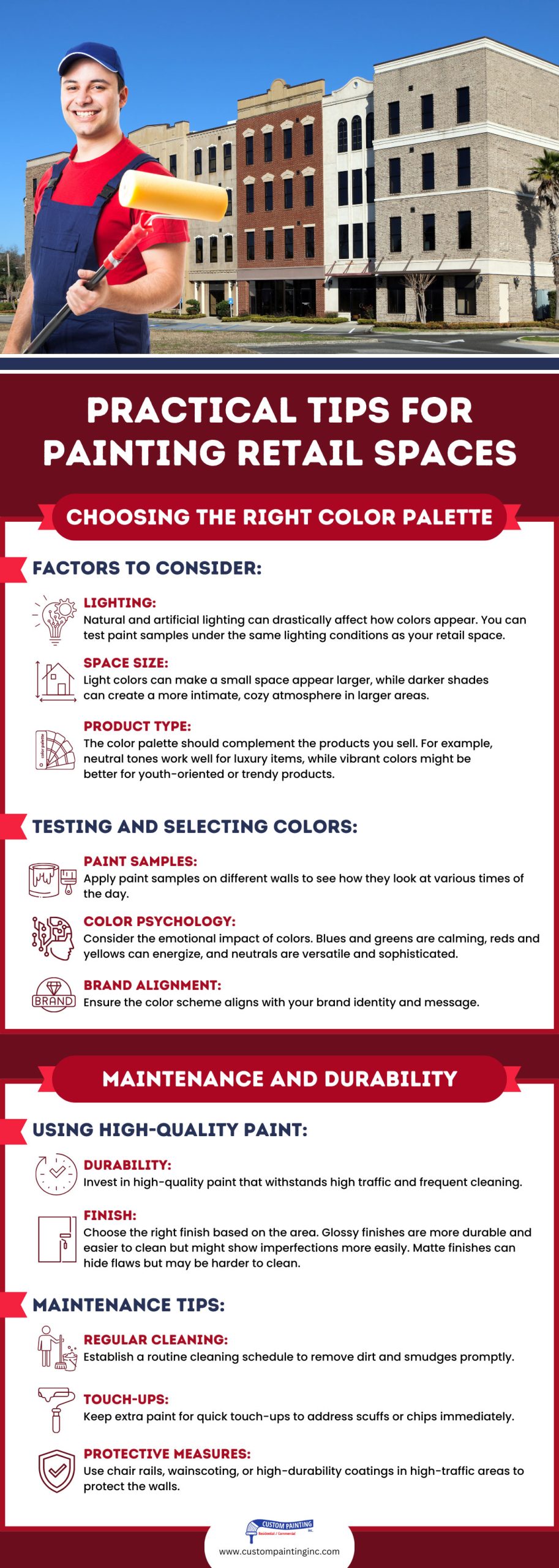As someone who owns and runs a shop or other retail space in the Pleasanton, CA area, you know that visual appeal is crucial in creating a welcoming retail atmosphere. It fosters customer engagement and drives sales.
However, the strategic use of paint and color is often an overlooked and under appreciated element of retail environment design. The strategic use of paint and color in retail spaces significantly enhances aesthetics and functionality, contributing to the business’s success. Color can influence customer mood and perception, encouraging them to spend more time and money.
Thoughtful color choices can also define different areas within the store, aiding in navigation and improving the overall shopping experience. The careful selection of colors reflecting their brand and meeting practical needs enables retail spaces to remain attractive, inviting, and operational.
The role of aesthetics in retail success
Aesthetics play a crucial role in the success of retail businesses in Livermore, CA for several reasons:
Power of first impressions – Aesthetic appeal forms the initial impression customers have of a store. This first impression can significantly influence whether customers want to enter and explore the store further.
Visual appeal and attraction – Visually appealing stores can attract more customers in Tracy, CA. Effective signage, window displays, and overall store layout can draw attention and create curiosity.
Creating an inviting atmosphere – Aesthetics contribute to the store, affecting customer comfort and willingness to spend time browsing. Factors like lighting, music, and even scent can enhance the ambiance.
Impact of color schemes and design – Colors and design choices influence customer mood and perception. For instance, warm colors like reds and oranges can create a sense of urgency or excitement, while cool tones like blues and greens might evoke calmness or trust.
Building brand identity – Aesthetic consistency across branding, store design, and packaging helps reinforce brand identity. It creates a memorable experience that customers can associate with the brand.
In essence, aesthetics in retail go beyond mere decoration; they shape customer experiences, affect perceptions, and ultimately impact sales and customer loyalty. Retailers who understand and leverage aesthetics effectively can create compelling environments that drive success.
Strategic use of color in retail spaces
Psychology of colors
Overview of how different colors influence emotions and behaviors
Colors play a significant role in influencing customers’ emotions and behaviors in retail environments.
- Warm colors (like red, yellow, and orange) usually evoke warmth and excitement but can also create a sense of urgency.
- Cool colors (like blue, green, and purple) are associated with calmness, relaxation, and trust.
- Neutral colors (like black, white, and gray) often provide a sophisticated and professional look, acting as a backdrop that makes other colors stand out.
Specific Colors and Their Effects on Customer Experience:
- Blue: Often used to create a calming and trustworthy atmosphere, blue is effective in settings where customers need to feel relaxed and assured, such as in healthcare or financial services.
- Red: This color can grab attention and create a sense of urgency. Red is commonly used in clearance sales or to highlight important information.
- Yellow: This warm color evokes happiness and optimism, making it suitable for stores wanting to create a cheerful environment. However, yellow can be overwhelming in large quantities.
- Green: Most people associate green with nature and health. This color creates a refreshing and tranquil ambiance. Green is often used in stores focusing on health, wellness, and eco-friendly products.
- Purple: Luxury and creativity are often linked to purple. This color can add sophistication and exclusivity to a retail space.
- Black and white: Black conveys elegance and sophistication, often used in high-end retail. White signifies cleanliness and simplicity, creating a modern and uncluttered look.
Brand identity and color
- Aligning color choices with brand identity and target market: Choosing the right colors is crucial for reinforcing brand identity and appealing to the target market. For instance, a brand that positions itself as eco-friendly might use green prominently to highlight its commitment to sustainability. A luxury brand might incorporate black and gold to convey sophistication and exclusivity.
- Consistency: Ensuring that the retail space’s color scheme aligns with the brand’s logo, packaging, and marketing materials helps create a cohesive and recognizable brand image.
- Target market considerations: Understanding the preferences and expectations of the target market is essential. For example, a store targeting younger audiences might use vibrant, playful colors, while one targeting older, more conservative shoppers might opt for more subdued and classic tones.
By thoughtfully selecting and applying colors in retail spaces in Dublin, CA, businesses can enhance the shopping experience, strengthen their brand identity, and ultimately influence consumer behavior positively.
Practical tips for painting retail spaces
Choosing the Right Color Palette
Factors to consider:
- Lighting: Natural and artificial lighting can drastically affect how colors appear. You can test paint samples under the same lighting conditions as your retail space.
- Space size: Light colors can make a small space appear larger, while darker shades can create a more intimate, cozy atmosphere in larger areas.
- Product type: The color palette should complement the products you sell. For example, neutral tones work well for luxury items, while vibrant colors might be better for youth-oriented or trendy products.
Testing and selecting colors:
- Paint samples: Apply paint samples on different walls to see how they look at various times of the day.
- Color psychology: Consider the emotional impact of colors. Blues and greens are calming, reds and yellows can energize, and neutrals are versatile and sophisticated.
- Brand alignment: Ensure the color scheme aligns with your brand identity and message.
Maintenance and durability
Using high-quality paint:
- Durability: Invest in high-quality paint that withstands high traffic and frequent cleaning.
- Finish: Choose the right finish based on the area. Glossy finishes are more durable and easier to clean but might show imperfections more easily. Matte finishes can hide flaws but may be harder to clean.
Maintenance tips:
- Regular cleaning: Establish a routine cleaning schedule to remove dirt and smudges promptly.
- Touch-ups: Keep extra paint for quick touch-ups to address scuffs or chips immediately.
- Protective measures: Use chair rails, wainscoting, or high-durability coatings in high-traffic areas to protect the walls.
Considering these practical tips allows you to create an attractive retail space that enhances customer experience and supports your brand.
The financial impact of well-painted retail spaces
Cost vs. benefit analysis
- Initial investment: The painting cost includes materials, labor, and potential disruptions to business operations. High-quality paint and professional services may incur higher initial costs.
- Long-term benefits:
- Aesthetic appeal: Well-painted spaces enhance the visual appeal, making them more inviting and attractive.
- Maintenance: High-quality paint can protect surfaces from wear and tear, reducing long-term maintenance costs.
- Perception of quality: A fresh, clean appearance can create a perception of quality and professionalism.
Return on investment
- Customer retention: A visually appealing environment can enhance customer satisfaction and encourage repeat visits. Customers are more likely to return to a well-maintained and visually pleasant place.
- Increased spending: Attractive spaces can influence customer behavior, potentially leading to more lingering stays and higher spending. For example, in retail and hospitality, a pleasing environment can enhance the customer experience, encouraging more purchases and positive reviews.
- Brand Image: A well-painted space can improve a San Ramon, CA business’s brand image, contributing to a positive reputation and potentially attracting new customers.
While the initial investment in interior and exterior painting may be significant, the long-term benefits in customer retention, increased spending, and enhanced brand image can provide a substantial return on investment.
Trends and innovations in retail space design
Current trends
Popular color trends in retail design
- Neutral tones: Retail spaces increasingly use neutral tones like whites, grays, and beiges. These colors create a clean, modern, and versatile backdrop that can highlight products effectively.
- Bold accents: While neutral tones dominate, bold accent colors create focal points and draw attention to specific areas or products. Bright colors like teal, mustard yellow, and coral are popular choices.
- Earthy and natural hues: There is a growing trend towards earthy and natural colors such as greens, browns, and terracottas. These colors convey a sense of sustainability and connection to nature.
Innovative approaches to using paint and design in retail spaces
- Murals and artistic walls: Incorporating murals and creative designs on walls is becoming popular in the Fremont, CA area. These elements can tell a brand’s story, create an Instagrammable moment, and enhance the overall aesthetic appeal.
- Color blocking: Using blocks of contrasting colors to define different areas within the store helps guide customers through the space and create distinct zones for various product categories.
- Interactive and dynamic surfaces: Some retailers are experimenting with interactive walls and surfaces that change colors or display digital content based on customer interaction, creating an engaging and immersive shopping experience.
Future directions in retail space design
Emerging technologies and materials
- Smart mirrors and augmented reality (AR): Smart mirrors that allow customers to virtually try on clothes and accessories are becoming more prevalent for Sunol, CA area retailers. AR can also enhance the shopping experience by providing additional product information and virtual demonstrations.
- Sustainable and recycled materials: The use of sustainable and recycled materials is set to increase, driven by consumer demand for environmentally friendly practices. These include reclaimed wood, recycled metal, and eco-friendly paints.
- Modular and adaptable design: Retail spaces are moving towards modular and flexible designs that can be easily reconfigured. This flexibility allows retailers to update their stores frequently to keep the shopping experience fresh and aligned with current trends.
- LED lighting and smart lighting systems: Energy-efficient LED lighting and smart lighting systems that adjust according to natural light levels and customer presence are becoming more common. These systems not only save energy but also enhance the visual appeal of the retail space.
These trends and innovations in retail space design aim to create more engaging, sustainable, and adaptable environments that meet the consumers’ evolving preferences.
Conclusion
The strategic use of paint and color in retail spaces enhances aesthetics, functionality, and business success by influencing customer mood, perception, and behavior, aiding navigation, and maintaining appeal over time.
Investing in your retail space is crucial for attracting and retaining customers. Creating an inviting and visually appealing environment enhances the shopping experience and boosts customer loyalty. For professional advice and assistance, contact our team from Custom Painting, Inc. to help transform your store and make a lasting impression on your customers. Call us at 925-294-8062 or complete our contact form whether you need professional paint advice or request an estimate.





